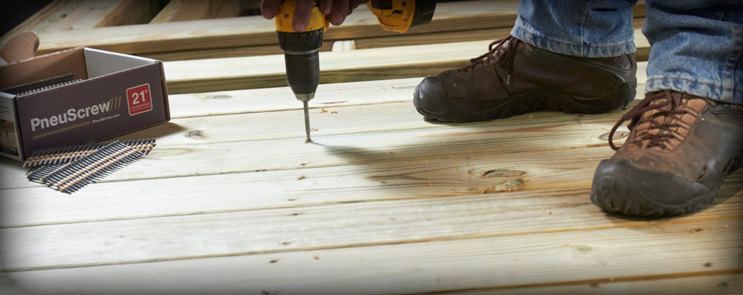
Frequently Asked Questions
Below are some frequently asked questions about PneuScrew®. Read on to learn more about our products' characteristics and use.
Will PneuScrews® work in my roofing coil or siding nailer?
No, PneuScrews® are designed to work in most Framing Nailers on the market.
Can we skip the subfloor adhesive if we use PneuScrews®?
No, always use the adhesive. The combination of the adhesive with PneuScrews® will assure a secure flooring assembly for decades.
How can PneuScrews® work with these small threads compared to wood screws?
With many more threads per inch, PneuScrews® contact the wood surface in more places gathering holding power from each contact point. Our patented designs allow PneuScrews® to be driven in without damaging the wood fibers.
Who should use PneuScrews®?
Anyone interested in getting the project done quickly using half the labor. In a subfloor time study, we showed 123% more production compared to old fashioned collated screws.
How do PneuScrews® withdrawal resistance compare to ring shank nails and regular screws?
PneuScrews® have about 35% more withdrawal resistance than ring shank nails and about 35% less withdrawal resistance compare to regular screws. "How much is enough?" PneuScrews® have more than adequate withdrawal resistance for most applications in construction. Remember, the codes are written around nails for most applications and we have about double the shear value of nails and way more withdrawal resistance.
What are the major advantages if I use PneuScrews® on my next construction project?
You get a cutting edge screw that saves more than half your labor cost or time and gives you a screwed assembly with optional removal or adjustment. No more finicky screw guns and bits. Now, you just load PneuScrews® in the pneumatic, battery, or gas framing nailer you already own and knock out the project.
Can I get a free sample to try?
Sure, samples are free and you will find PneuScrews® work in all kinds of sheathing applications for roofing, siding, subfloors as well as crating and pallets.
What size PneuScrew® do I need to use?
Subfloors and sheathing with ⅝" thickness need to use our 2¼" x .113 PneuScrews®. Our IAPMO ES Report #0133 is recognized by IBC and IRC worldwide and has about thirty items listed on page three. If you use thicker materials, please use a longer (2½" or 3") PneuScrew® to give you extra holding power. Your tool will not know the difference in length, but you might need to go up on your air pressure to drive them flush with the work surface.
How much air pressure do I need?
Normal sheathing applications like roofing, flooring, and shear walls will require about 110 lbs. of air pressure for pneumatic tools. If you use a tool with depth of drive adjustment, this helps make every drive perfect but these are screws and can be adjusted. If you hit a hard spot and it leaves the PneuScrew® up, you can just hammer it into place with one blow.
Should we ware safety glasses and other safety items when using PneuScrews®?
Absolutely everyone on the jobsite should be wearing safety glasses to be as safe as possible. Eyes are sensitive and PneuScrews® are strong enough to drive into 12 to 16 gauge steel in some special applications.
How many fasteners come in a box?
PneuScrew fasteners are available in a variety of quantities depending on the type, style or size of the fastener.
How do I determine the appropriate length of PneuScrew?
The length of the fastener will depend on the materials to which it is attaching to the substrate material. In wood, the length of the fastener should allow the threads to penetrate the substrate at least 1” or more. When attaching to 12-16 gauge metal, the length of the fastener should only allow two to five threads to penetrate the metal. Calculate in the thickness of the material you are fastening and allow for the appropriate penetration into the substrate.
How much money will I save using PneuScrew?
More than twice as fast as collated screws, these revolutionary and patent pending pneumatic fasteners help save time by reducing on-site labor costs. Use our Cost-Savings Calculator to estimate how much money you can save using PneuScrew for your next project.
What is pull-out resistance?
The amount of force (measured in pounds) needed to withdraw a fastener from the material or substrate. For example: The 2¼” PneuScrew fastener averaged 523 lbs to 533 lbs in Southern Yellow Pine Testing in 2006. Intertek Report #3100366-001.
Are PneuScrew fasteners code-compliant for shear wall installation?
Currently there are (4) four PneuScrew fasteners that are code-compliant for shear wall installation.
20-Degree Plastic Strip:
2-1/4" x 0.113 #2 Phillips drive, 3" x 0.113 #2 Phillips drive, yellow zinc coated,
15-Degree wire coil:
2-1/4" x 0.113 #2 Phillips drive, yellow zinc coated, 2-1/2" x 0.113 #2 Phillips drive, yellow zinc coated
What is shear strength?
Shear strength is the maximum load applied to a fastener’s axis before it will fracture or split, essentially causing the fastener to break in half. Shear strength is usually specified in pounds per square inch (PSI). Single shear values for fasteners are typically calculated based upon the nominal body diameter or body shear area, BSA.
What coating options are available for PneuScrew® fasteners?
- Interior or temporary, use (YZ) yellow zinc dichromate.
- Exterior use in ACQ or MCQ treated lumber, use PT2000®, PPG 1500™, or stainless steel.
- Around salt water or brackish water, use 305 or 316 stainless steel only.
What applications are appropriate for using PneuScrew fasteners?
Versatility is the main advantage for PneuScrew fasteners. The application possibilities are virtually endless. Common applications range from decking, crating, pallets, concrete forms, fencing, fiber-cement siding, roofing, sub-flooring, sheathing, manufactured housing, and many more.
Where can I purchase PneuScrew fasteners?
All PneuScrew pneumatic fasteners are available online as NailScrews®.